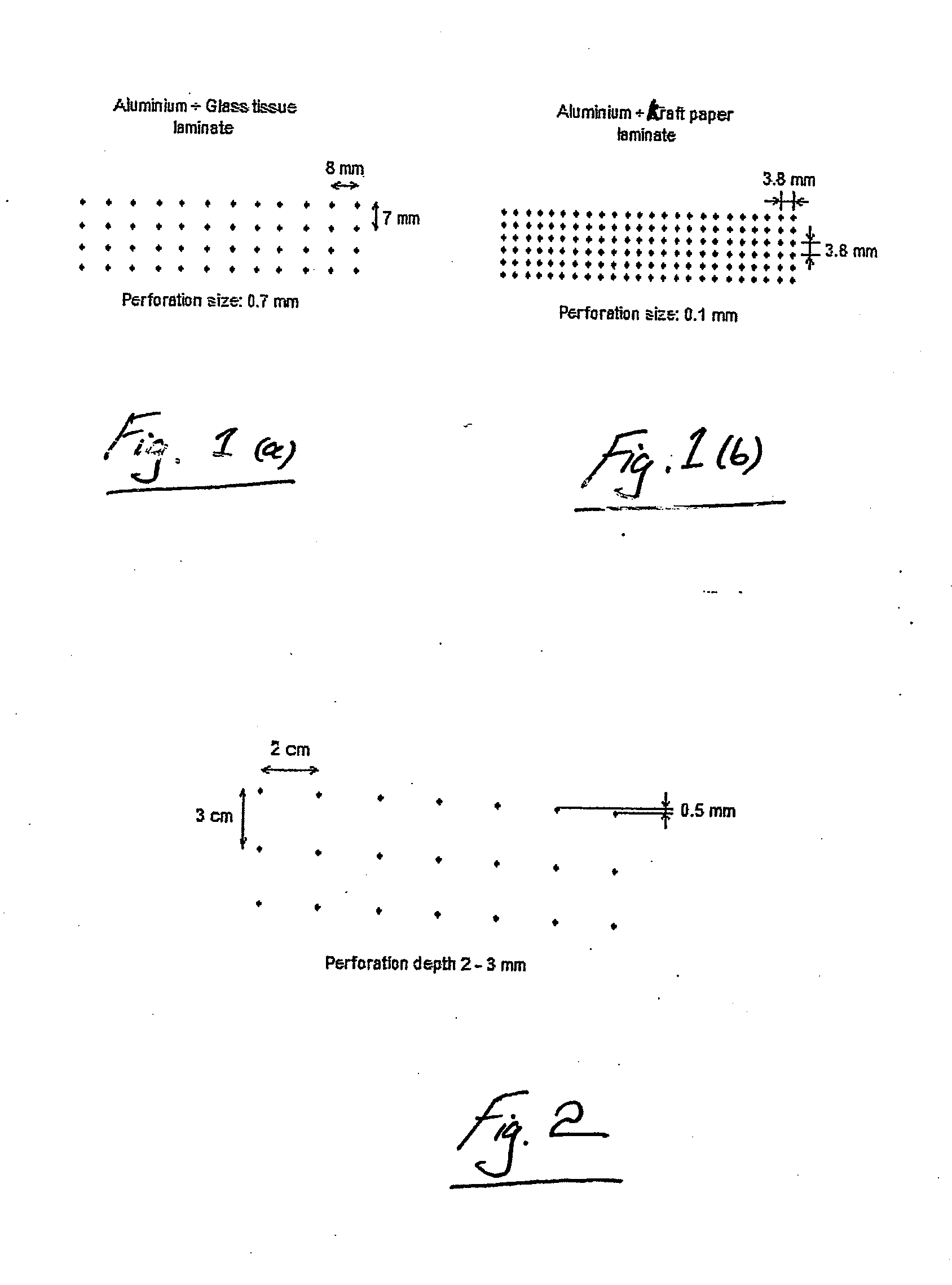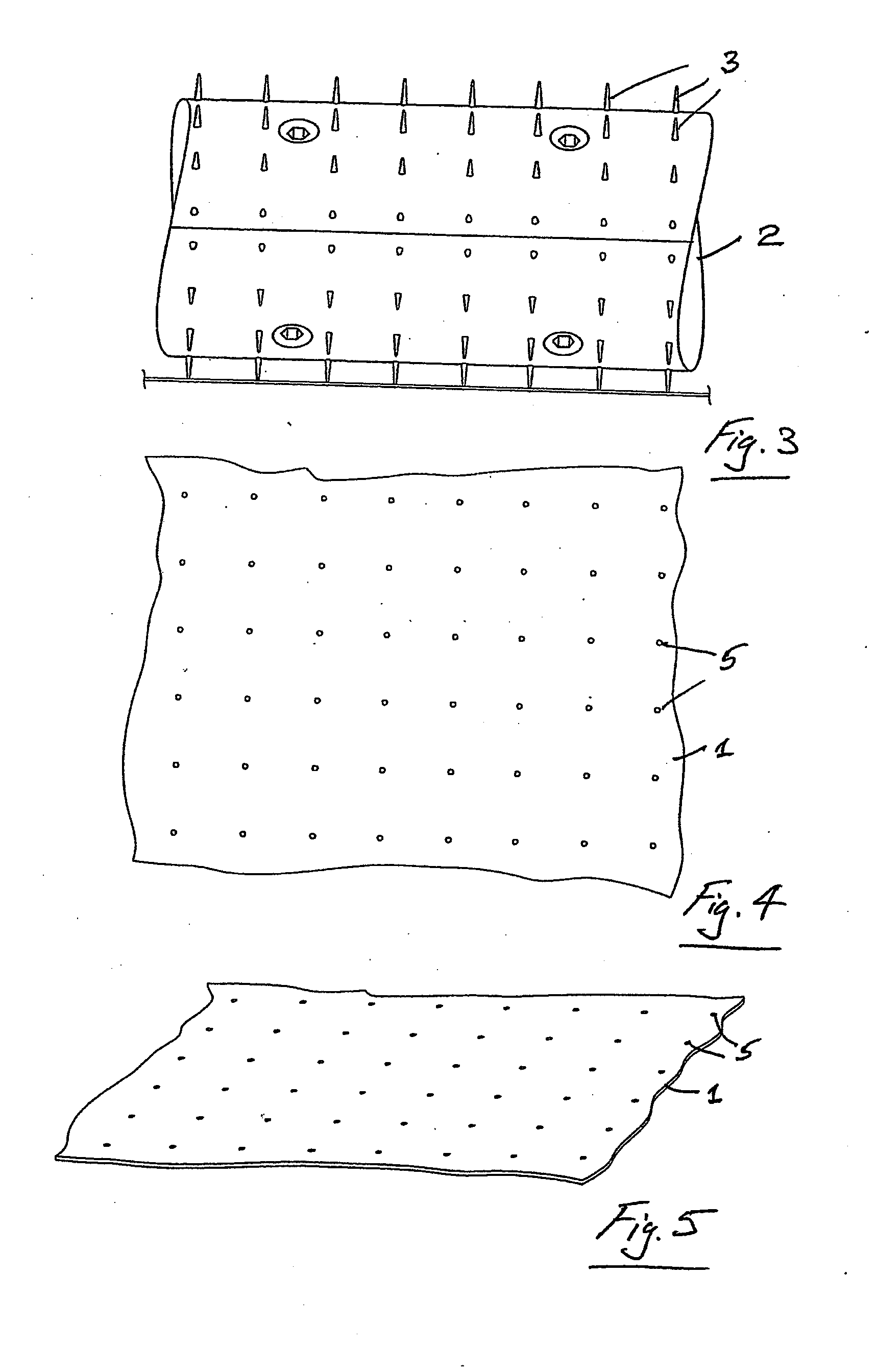Phenolic foam board
a technology of phenolic foam and foam board, which is applied in the field of phenolic foam board, can solve the problems and achieve the effect of reducing drying and curing time and improving the thermal conductivity of aged products
- Summary
- Abstract
- Description
- Claims
- Application Information
AI Technical Summary
Benefits of technology
Problems solved by technology
Method used
Image
Examples
example 1
[0047]In this case, the perforations are made in the facing itself, before the foaming process.
[0048]For this purpose, two different facings where perforated and used to make foam panels. The first facing consisted of an aluminium foil laminated onto glass tissue.
[0049]Referring to FIGS. 3 to 8 the facings 1 may be perforated using a spiked roller 2 with a plurality of spikes 3 which form a plurality of perforations 5 in the facing 1. A spiked roller is described in GB-A-2,383,971.
[0050]The perforation pattern for the aluminium-glass fibre facing, and the perforation size of 0.7 mm are given in FIG. 1(a).
[0051]With both facings perforated, phenolic foam insulation panels 8 with a thickness of 50 mm were produced.
[0052]Phenol formaldehyde foam insulation boards, with a thickness of 50 mm, were produced with gas impermeable facings comprising aluminium foil laminated onto glass tissue. The perforated facing was used as a facing on both sides. According to the process for producing phe...
example 2
[0058]Phenol formaldehyde foam insulation boards, with a thickness of 80 mm, were produced with a gas impermeable two-layer aluminium foil—glass fibre tissues laminate facing on both sides. The assembly of this two-layer facing was arranged such that the glass fibre layer of the two-layer facing was bonded to the phenolic foam. According to the process for producing phenolic foam of the present invention, a foamable phenolic resin composition is discharged on to a continuous running facing and passed through a heated zone for foaming and moulding into phenolic foam products of predetermined shape. In this manufacturing process, the phenolic resin composition that has been discharged on to the running facing material supported by a conveyor belt that passes into a heated oven typically at 50 to 100° C. for approximately 2 to 15 minutes. The top surface of the rising foam composition is pressed down with another facing material carried by an upper conveyor belt. The thickness of the f...
example 3
[0068]Phenolic foam was produced with a thickness of 40 mm. In the same way as in Example 2, the product was faced on both sides with a gas impermeable two layer aluminium-glass tissue facing. This insulation panel sample was then perforated on one side as described above. The pattern and depth of the perforations is shown in FIG. 2.
[0069]As with Example 2, these samples were placed in a drying oven and conditioned at 70° C. Alongside this sample was a reference sample which was non-perforated. Also present in this evaluation was a sample that was faced with plain glass tissue.
[0070]Table 4 gives the weight loss of these three samples as function of the drying time
TABLE 4Weight loss as function of the dryingtime (product thickness 40 mm)DescriptionDataProduct thickness [mm]40404040Drying time [hours]1234Drying temperature [° C.]70707070Weight loss double sided aluminium foil-0.140.170.210.52glass fibre faced product no perforations[w %]Weight loss double sided aluminium foil-1.212.7...
PUM
| Property | Measurement | Unit |
|---|---|---|
| thermal conductivity | aaaaa | aaaaa |
| diameter | aaaaa | aaaaa |
| diameter | aaaaa | aaaaa |
Abstract
Description
Claims
Application Information
 Login to View More
Login to View More - R&D
- Intellectual Property
- Life Sciences
- Materials
- Tech Scout
- Unparalleled Data Quality
- Higher Quality Content
- 60% Fewer Hallucinations
Browse by: Latest US Patents, China's latest patents, Technical Efficacy Thesaurus, Application Domain, Technology Topic, Popular Technical Reports.
© 2025 PatSnap. All rights reserved.Legal|Privacy policy|Modern Slavery Act Transparency Statement|Sitemap|About US| Contact US: help@patsnap.com



